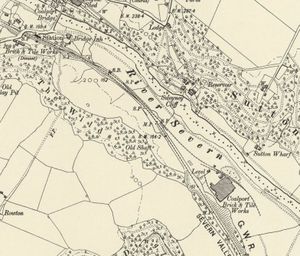Coalport Brick & Tile Works Siding
The Coalport Brick & Tile Works was situated south of Coalport Station. The works and its siding can be seen on the lower right in the extract from the Ordnance Survey map published in 1903. Coalport station is towards the upper left. Entry to the siding was controlled by Coalport signal box (marked 'S.B.' on the map extract) which also controlled access to the adjacent Coalport passing loop.
History of the Works
In 1891 Exley & Sons sunk a clay mine known as Gitchfield Clay Mine and begun constructing a large brick and tile works. In May of that year they notified the GWR of their intention to extract clay from beneath the railway. On 18 June 1891 the GWR entered into an agreement that Exley's would not extract coal or other minerals in the vicinity of the railway, in return for which the GWR would construct a siding at a cost of £228 and lend Exley's material to extend it for 550 yards.[1][2]
Three years later in 1894 the Works, also known as "Coalport Tileries" began tile production.[1] In the same year, GWR General Manager Henry Lambert proposed that Coalport should become a crossing station with a passing loop and additional sidings to serve Exley's works. These improvements, including the signal box, were approved by the Board of Trade on 22 January 1896.[2] In 1906 a branch of the siding was added to the west of the Works (shown as a disconnected line on the 1903 map).
During both World Wars, the Works was requisitioned for munitions purposes. Coalport Refractories continued to use the private siding until 1956[3]. The Works had closed by 1963[4] and by 1981 the historic buildings had been demolished and replaced by a Sewage Reclamation Works[5].
References
- ↑ 1.0 1.1 Coalport Station History Retrieved 14 May 2018
- ↑ 2.0 2.1 Marshall (1989) pp. 108-109.
- ↑ Mitchell & Smith (2007) fig. XVI.
- ↑ ShropshireHistory.Com (retrieved 14 May 2018)
- ↑ Shropshire Historic Environment Record for Coalport Brick And Tile Works (retrieved 14 May 2018)
